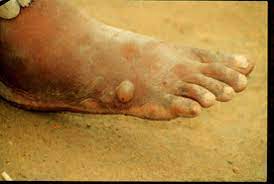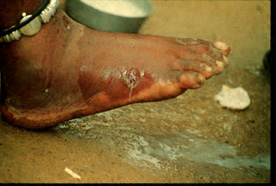Author's details
- Dr Khashau Eleburuike
- MBBS (Ilorin) MSc. Global Health Karolinska Institute.
- Resident doctor in family medicine in Northern Sweden.
Reviewer's details
- Dr Gboyega Olarinoye
- MBBS, FMCP.
- Dermatologist at FMC Keffi Nassarawa State. Nigeria
- Date Uploaded: 2025-01-04
- Date Updated: 2025-08-11
Guinea worm
Guinea worm disease, caused by Dracunculus medinensis, is prevalent in some parts of Sub-Saharan Africa, particularly in remote rural areas with limited access to clean water. The parasitic infection occurs when people drink water contaminated with Guinea worm larvae, leading to painful blisters as adult worms emerge through the skin. Treatment involves carefully extracting the worm over several days, combined with wound care and preventing further contamination of water sources, while eradication efforts focus on improving access to safe drinking water and health education.

CDC - DPDx - Dracunculiasis Figure A: The female Guinea worm induces a painful blister. Text source: CDC

CDC - DPDx - Dracunculiasis Figure B: after rupture of the blister, the worm emerges as a whitish filament in the center of a painful ulcer which is often secondarily infected. (Images contributed by Global 2000/The Carter Center, Atlanta, Georgia). Text source: CDC DPDx (51)Text source: CDC DPDx - Laboratory Identification of Parasites of Public Health Concern

- Muller R. Guinea worm disease: epidemiology, control, and treatment. Bulletin of the World Health Organization. 1979;57(5):683.
- Cairncross S, Muller R, Zagaria N. Dracunculiasis (Guinea worm disease) and the eradication initiative. Clinical Microbiology Reviews. 2002 Apr;15(2):223-46.
- 2018; Available at: https://www.cdc.gov/dpdx/dracunculiasis/index.html. Accessed 0215, 2024.
- 2024; Available at: https://en.wikipedia.org/wiki/Dracunculiasis. Accessed 0215, 2024.

